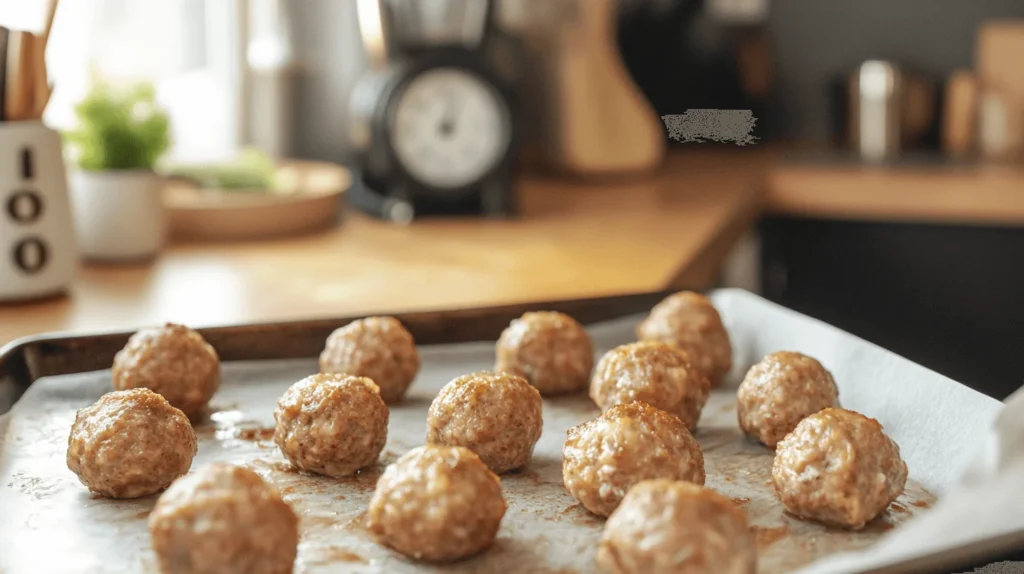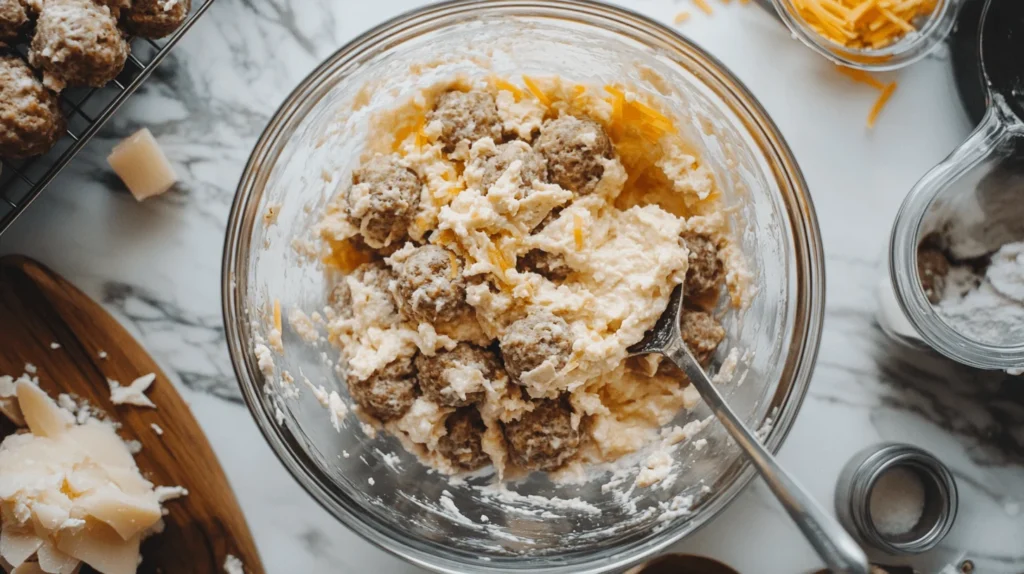When preparing sausage balls, many home cooks encounter a frustrating issue: dry sausage balls. If you’ve ever wondered why are my sausage balls so dry, you’re not alone. Dry sausage balls are a common problem, and understanding the reasons behind this issue is key to achieving the perfect texture and flavor. Sausage balls are typically enjoyed for their tender, juicy texture, but achieving that consistency can sometimes be tricky. In this article, we will break down the most common causes of dryness and provide effective solutions for fixing dry sausage balls. Whether you’re a seasoned cook or a beginner, these tips will help you troubleshoot and perfect your sausage ball recipe.
Understanding why are my sausage balls so dry is the first step to making them more flavorful and moist. By examining common causes like overbaking, using the wrong type of sausage, or improper binding, you can fix your sausage balls and ensure they remain delicious and tender. Along the way, we will also explore ways to add moisture, choose the right sausage, and select the best ingredients to create sausage balls that everyone will love.
Common Reasons for Dry Sausage Balls
Understanding why sausage balls can turn out dry involves looking into several key factors. Many cooks unknowingly make mistakes that result in dry sausage balls, but once you identify these common issues, they can be easily avoided. Let’s explore the most frequent reasons for dryness in sausage balls and learn how to correct them.
Overcooking or Overbaking
One of the most significant contributors to dry sausage balls is overcooking or overbaking. When sausage balls are left in the oven too long, they lose moisture and become tough. Overcooking often happens when the baking time exceeds the recommended duration or when the temperature is too high.
- Solution: To avoid this, it’s crucial to monitor the cooking process closely. Use a thermometer to check if the internal temperature of the sausage balls has reached 165°F (74°C) for safe consumption. Once they reach the right temperature, remove them from the oven immediately to prevent overcooking. You can also explore sausage balls without Bisquick for a different approach to achieving moisture balance.

Using Lean Sausage
While lean sausage is a healthier option, it can also be the culprit behind dry sausage balls. Lean sausage contains less fat, which results in less moisture in the sausage balls. Fat is necessary to maintain the tenderness and juiciness of the meat.
- Solution: To fix this, opt for a sausage with higher fat content or add additional fat sources, such as butter or cream cheese, to your sausage ball mixture. This will help keep your sausage balls moist and flavorful. You might also find helpful insights on alternatives for Bisquick to refine your recipe.
Insufficient Binding Ingredients
Binding ingredients like eggs, flour, or breadcrumbs play a crucial role in holding sausage balls together. If there isn’t enough binder in the mixture, the sausage balls will fall apart and lack moisture, resulting in a dry texture.
- Solution: Increase the amount of binder or use the right types of binders. A balance of flour, breadcrumbs, and eggs will help retain moisture and hold the sausage balls together without making them too dense. For further ideas, check out Bisquick alternatives for sausage balls.
Not Enough Fat or Moisture
Fat and moisture are essential for juicy sausage balls. Without enough moisture, the sausage balls become dry, and the texture suffers. Some recipes may not include enough fat or moisture-rich ingredients.
- Solution: Adding ingredients like sour cream, yogurt, or cream cheese can improve moisture levels. Make sure you’re using enough fat in your recipe to keep the sausage balls from becoming dry and crumbly.
Too Much Flour or Breadcrumbs
Using too much flour or breadcrumbs can cause the sausage balls to become too dry. While these ingredients are important for binding, they can absorb moisture and leave the sausage balls dry if used in excess.
- Solution: Stick to the recommended proportions for flour and breadcrumbs. Reducing the amount slightly can help prevent the mixture from becoming too dry and ensure your sausage balls are moist and tender.
How to Fix Dry Sausage Balls
If you’ve made a batch of dry sausage balls, don’t worry. There are several ways to fix them, and with a few simple adjustments, you can turn dry sausage balls into a moist and delicious treat. Let’s explore some effective strategies to bring moisture back to your sausage balls.
Adding More Moisture: Sauces, Cream Cheese, and Other Ingredients
One of the best ways to add moisture to dry sausage balls is by incorporating ingredients like cream cheese, sour cream, or a flavorful sauce. These ingredients not only increase moisture but also enhance the flavor profile.
- Cream cheese: Adding cream cheese to your sausage ball mixture provides richness and moisture, resulting in a soft and flavorful texture.
- Sour cream or yogurt: These dairy products can also help add moisture without making the sausage balls greasy.
- Sauces: Adding a bit of your favorite sauce, like barbecue or ranch dressing, can also help restore moisture while enhancing the flavor.

Adjusting the Cooking Method
Sometimes, the problem lies in the cooking method rather than the ingredients themselves. Dry sausage balls often result from cooking them too long or at a high temperature.
- Solution: Try lowering the cooking temperature slightly and keep a close eye on the sausage balls. Baking at 350°F (175°C) for about 20-25 minutes should yield tender and juicy sausage balls. Using a lower cooking temperature helps the sausage balls cook evenly and retain moisture.
Using the Right Sausage Fat Content
Choosing the right type of sausage is critical for ensuring your sausage balls remain moist. If you’ve been using lean sausage, it’s time to switch to a sausage with higher fat content.
- Solution: Select regular or higher-fat sausage for your recipe. This will ensure the sausage balls remain juicy and flavorful. You can also experiment with adding extra fat sources, like butter or olive oil, to boost the moisture content.
Experimenting with Flavor Enhancers
Sometimes, dry sausage balls can result from using bland or overly dry ingredients. Flavor enhancers like herbs, spices, and additional fats can improve both the moisture and flavor.
- Solution: Experiment with adding herbs like parsley or sage, and try different spices such as garlic powder, onion powder, or paprika. Additionally, using a flavorful fat, like butter or even bacon grease, can elevate both moisture and taste.
The Role of Moisture in Sausage Balls
Moisture plays a significant role in the texture and flavor of sausage balls. Without enough moisture, the balls will become dry and tough, lacking the soft, tender consistency that makes sausage balls so appealing. Let’s take a deeper look into why moisture is essential in sausage balls and how to manage it.
Why are my sausage balls so dry? Importance of Moisture in Cooking
Moisture helps to break down proteins during cooking, ensuring the sausage balls remain tender. Without enough moisture, the proteins in the sausage become too firm and the result is dry, dense sausage balls. Moisture also ensures the other ingredients, such as breadcrumbs or flour, absorb enough liquid to create a soft, cohesive mixture.
Why are my sausage balls so dry? Ways to Add Moisture without Overwhelm
While moisture is crucial, it’s important not to add too much liquid. Over-wetting the mixture can make it too sticky and cause the sausage balls to fall apart during cooking.
- Solution: Start with small amounts of moisture-rich ingredients, such as cream cheese or yogurt, and adjust based on the consistency of the mixture. It’s better to add moisture gradually to maintain control over the texture of the sausage balls.
Choosing the Right Sausage for Moisture
The sausage you choose significantly impacts the moisture content of your sausage balls. Lean sausage, while lower in fat, can leave your sausage balls dry and crumbly. Understanding how different types of sausage affect moisture is essential for creating the perfect sausage balls.
Fat Content and Its Impact on Texture
Fat is the key to ensuring moisture in sausage balls. Sausage with a higher fat content contributes to a juicy texture, while lean sausage can lead to a dry, dense final product. Higher-fat sausage will melt and release moisture during cooking, keeping your sausage balls tender.
Difference Between Regular vs. Lean Sausage
Regular sausage typically contains 20-30% fat, while lean sausage has 10% or less. The higher fat content in regular sausage adds essential moisture and flavor, while lean sausage often results in dry sausage balls. If you prefer a leaner option, consider adding additional fat sources to maintain moisture.
Binding Ingredients for Sausage Balls
Binding ingredients, such as eggs, flour, and breadcrumbs, are essential for creating sausage balls with the right texture. The right balance ensures your sausage balls hold together while retaining moisture. Let’s explore how to use these ingredients effectively.
How to Use Eggs, Flour, and Other Binders Effectively
Eggs are the primary binding agent in sausage balls, helping to hold the mixture together while providing moisture. Flour and breadcrumbs also help bind the mixture, but they can absorb moisture if used in excess.
- Solution: Use a balance of eggs, breadcrumbs, and flour. A typical ratio is one egg per pound of sausage. Avoid using too much flour, as it can absorb moisture and lead to dry sausage balls.
Proportions of Binders to Avoid Dryness
To ensure your sausage balls stay moist, stick to the recommended proportions of binding ingredients. Too much flour or breadcrumbs can absorb moisture, while too few eggs or other binders can cause the mixture to fall apart.
- Solution: A good rule of thumb is to use about ½ cup of breadcrumbs and ¼ cup of flour for each pound of sausage. This will provide enough structure without drying out the sausage balls.
How Fat Affects Sausage Balls
Fat is crucial for both moisture and flavor in sausage balls. Sausage balls made with low-fat sausage often turn out dry, lacking the richness and moisture that make them so delicious. Let’s dive into why fat is so essential for creating moist sausage balls.
Why Fat is Crucial for Moisture and Texture
Fat helps to keep the sausage balls juicy by preventing the proteins from becoming too firm. When fat cooks, it melts and adds moisture, which keeps the sausage balls tender and flavorful.
- Solution: Use sausage with a higher fat content to achieve the best texture. If you’re using lean sausage, consider adding extra fat, such as butter or oil, to compensate.
Best Fat Content for Sausage Balls
The ideal fat content for sausage balls is between 20-30%. This range ensures that the sausage balls are juicy and flavorful without being overly greasy.
- Solution: Look for sausage that contains at least 20% fat. You can also experiment with adding other fat sources, such as butter or cream cheese, to further enhance the moisture content.
The Importance of Not Overmixing
Overmixing your sausage ball mixture can lead to a tough and dry texture. It’s essential to mix the ingredients just enough to combine them without overworking the meat. Here’s how to avoid overmixing and keep your sausage balls tender.
Why Overmixing Leads to Dry Sausage Balls
When you overmix the ingredients, the protein in the sausage becomes overly activated, leading to a tough texture. This results in dry, dense sausage balls that lack the desired tenderness.
- Solution: Mix the ingredients gently until just combined. Avoid excessive kneading or stirring, as this can cause the sausage balls to become tough.
Techniques to Mix Ingredients Properly
To properly mix the sausage ball ingredients, use your hands or a spoon to gently combine the sausage, eggs, breadcrumbs, and other ingredients. Be careful not to overwork the mixture, and avoid using a food processor or mixer, as these can overmix the ingredients.
How to Adjust Cooking Time and Temperature
Cooking time and temperature play a crucial role in ensuring your sausage balls remain moist. Overcooking at high temperatures can cause the sausage balls to dry out. Here’s how to adjust cooking time and temperature to avoid dryness.
The Right Temperature for Perfect Sausage Balls
The ideal temperature for cooking sausage balls is 350°F (175°C). Baking at this temperature allows the sausage balls to cook through without drying out. If the temperature is too high, the sausage balls will cook too quickly on the outside, leaving the inside dry.
Cooking Times to Avoid Dryness
Cooking sausage balls for too long can result in a dry texture. Aim for 20-25 minutes of cooking time, checking the internal temperature with a meat thermometer to ensure they reach 165°F (74°C).
Testing Sausage Balls for Doneness
Knowing when your sausage balls are done is essential to avoiding overcooking and dryness. Several methods can help you determine when your sausage balls are fully cooked without compromising moisture.
Methods to Check if Sausage Balls Are Done
Use a meat thermometer to check the internal temperature of the sausage balls. Once they reach 165°F (74°C), they are fully cooked and safe to eat. Alternatively, you can cut one sausage ball in half to check if it’s cooked through.
Signs of Overcooking to Avoid
Overcooked sausage balls will become dry and tough. If the sausage balls are too firm to the touch or have browned excessively, they are likely overcooked. Aim for golden-brown sausage balls that are still soft and tender inside.
How to Add Flavor without Compromising Moisture
Adding flavor to sausage balls is essential, but it’s important not to sacrifice moisture in the process. You can enhance the flavor without making the sausage balls dry by balancing moisture and flavorings.
Using Herbs, Spices, and Other Flavorings
Herbs and spices like garlic, onion powder, and parsley can add depth and flavor to sausage balls without affecting moisture. Fresh ingredients like chopped onions or bell peppers can also contribute moisture while enhancing flavor.
Balancing Moisture with Flavor for Best Results
To balance moisture and flavor, add small amounts of herbs, spices, and other ingredients. Taste the mixture as you go and adjust accordingly to ensure that the sausage balls are both flavorful and moist.
Alternative Sausage Ball Recipes
If you’re looking for a variation on traditional sausage balls, there are plenty of options to consider. Here are a few ideas for healthier or alternative sausage ball recipes that maintain moisture.
Healthier Versions with More Moisture
For a healthier sausage ball recipe, try using ground turkey or chicken sausage. These options contain less fat but can still remain moist by adding ingredients like Greek yogurt or vegetables like zucchini or spinach.
Vegetarian and Vegan Options
Vegetarian and vegan sausage ball alternatives can be made using plant-based ingredients like tofu, tempeh, or chickpeas. These can be combined with binders like breadcrumbs and vegan cheese to ensure the texture remains moist and flavorful.

Troubleshooting Common Sausage Ball Problems
If you’re still encountering issues with dry sausage balls, it’s helpful to troubleshoot and identify any additional factors that may contribute to dryness. Here’s how to fix common sausage ball problems.
Other Factors that Could Contribute to Dryness
Overcooking, insufficient fat, or incorrect ingredient ratios can all lead to dry sausage balls. Check your recipe and cooking techniques to ensure you’re using the right methods for a moist result.
Step-by-Step Troubleshooting for Perfect Sausage Balls
Start by reviewing your ingredients, cooking time, and temperature. Make adjustments as needed, such as using a higher-fat sausage, adjusting the cooking temperature, or incorporating moisture-rich ingredients.
Frequently Asked Questions (FAQs)
Here are some common questions about dry sausage balls and how to solve them.
Common Causes and Fixes for Dry Sausage Balls
Dry sausage balls are typically caused by overcooking, using lean sausage, or insufficient moisture. Fix these issues by adjusting your ingredients, fat content, and cooking methods.
How to Make Sausage Balls Moist without Sacrificing Taste
Add moisture-rich ingredients like cream cheese or sour cream and balance them with flavorful herbs and spices. This will keep your sausage balls moist without sacrificing flavor.
How Do I Keep Sausage Balls Moist When Storing?
Store your sausage balls in an airtight container in the refrigerator to preserve their moisture. You can also reheat them in the microwave with a damp paper towel to maintain moisture.
Can I Use Different Types of Sausage for Moisture?
Yes, you can experiment with different types of sausage, such as regular sausage, turkey sausage, or chicken sausage. Each type will affect the moisture content, so choose based on your preferences.
How Do I Avoid Overcooking Sausage Balls?
Monitor the cooking time carefully and use a meat thermometer to check the internal temperature. Once the sausage balls reach 165°F (74°C), remove them from the oven to prevent overcooking.
What Are the Best Ingredients for Sausage Balls?
The best ingredients for sausage balls include a higher-fat sausage, eggs, breadcrumbs, and moisture-rich ingredients like cream cheese or sour cream. The right balance of these ingredients will ensure your sausage balls stay moist and flavorful.
Conclusion
If you’ve ever asked why are my sausage balls so dry, this guide provides you with the answers you need to solve the problem. By understanding the role of fat, moisture, binding ingredients, and proper cooking methods, you can create sausage balls that are tender, juicy, and full of flavor.

